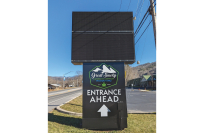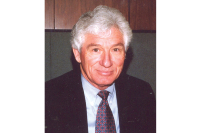HCC has very little risk on green energy venture, say experts
Alternative energy has emerged as a sticking point in the debate over a proposed $10 million creative arts building at Haywood Community College.
The project is in limbo as it awaits approval from county commissioners, who have expressed reservations for the past several months over the building’s price tag. Critics believe college leaders are being overzealous in their pursuit of eco-friendly building features, and the cost is being driven up as a result. They fear HCC is pushing the envelope with cutting-edge solar technology, making it a guinea pig in the alternative-energy field.
But supporters say the alternative energy features are smart. They will save the college money over the long run for no additional upfront cost, allowing the college to “go green” risk free and even benefit financially.
The Haywood Community College Board of Trustees voted 6 to 5 last month to include a solar technology in the building design. The final decisions now rests in the hands of county commissioners.
At a public hearing on the project last week, county commissioners pressed the project’s lead architect and an alternative energy firm engaged to install the solar technology to explain how it would work. The Smoky Mountain News conducted follow-up interviews with the firms, as well as experts at the N.C. Solar Center housed at N.C. State University, to get answers on all the solar aspects of the project — and then some.
Related Items
What kind of alternative energy are we talking about?
The design calls for three technologies: solar thermal for hot water and heat, solar thermal for air conditioning and solar panels for electricity.
Solar panels are nothing new. Mounted on the roof, the panels convert the sun’s rays to electricity.
Solar thermal uses the sun to heat water flowing through coils on the roof, which in turn provides hot water for the building. Hot- water pipes also run beneath the floor to provide radiant heating in the winter, similar to a radiator.
For the air conditioning, solar thermal heat will be used to power an absorption chiller.
How much does all this cost upfront?
Nothing. Sounds too good to be true, but HCC pays nothing. A private alternative energy firm, FLS Energy, will pay for the solar thermal system and solar panels.
“We finance the project, we design it, develop it and install it,” said Michael Shore, CEO of FLS Energy.
Why would FLS do that?
FLS will make money by selling energy to HCC and to Progress Energy over the power grid.
“We are like a little tiny utility on their roof,” Shore said.
FLS will get a bank loan for the up-front costs of the equipment and pay off the loan by selling the power. In about 10 years, FLS will have recouped its costs.
“It is a good business investment for us. Over the long term we pay off the debt and make a profit,” Shore said. “The financial arrangement we have done many times with very successful results.”
Where do tax credits come in?
State and federal tax incentives for solar energy are a critical piece of the puzzle for FLS. The venture wouldn’t be profitable without them.
But FLS doesn’t have enough tax liability of its own to fully monetize the tax credits. So a third-party investor is brought in to the venture to make use of the tax credits.
What does FLS sell to Progress Energy?
Unfortunately, FLS can’t sell electricity generated from the solar panels directly to HCC. Utilities have monopolies in their territory.
“In North Carolina the only entities you can buy electricity from are the utilities,” Shore said.
So the solar electricity will be sold to Progress. A new state energy bill requires Progress to generate a portion of its electricity from renewable sources. That means Progress is not only willing to buy the solar power from FLS, but will pay a premium for it — another critical element in the business model for FLS.
Meanwhile, FLS will pay HCC for the privilege of housing the solar panels on its roof. While HCC will have to buy its electricity the regular way, its power costs will be offset by the regular payments from FLS.
What does FLS sell to HCC?
FLS can, however, sell energy generated by the solar thermal system directly to HCC. Solar thermal energy is measured in heat units known as BTUs — so it is technically more like natural gas than electricity. FLS will charge HCC for the BTUs it uses.
What will the college pay FLS for the BTUs?
Whatever the rate is, it will be lower than what HCC would pay for comparable power on the open market, and it is locked in through a contract and not subject to rising energy costs.
“It does save them a significant amount in energy cost during the contract period,” said Dale Freudenberger, president of FLS. “It will absolutely be saving them money.”
If it is such a sure-fire business model, why aren’t more people doing it?
It sounds too good to be true. There’s no upfront costs or risk for HCC. The college even reaps savings on its power bills and gets kickbacks from FLS — thus making money while “going green.”
“It turns out to be a pretty good deal,” said Tim Lupo with the N.C. Solar Center.
A progressive state energy policy has only recently set the stage for arrangements like this one. Big utilities in North Carolina must now get a portion of their power from renewable sources.
The financial arrangement like the one between FLS and the college is increasingly common, according to Lupo. But the tax credits and alternative energy mandates are new, and firms like FLS are just now starting to figure it out.
What happens when FLS has recouped its costs?
In 10 years, HCC will have the option of buying the entire solar power system. It will have another 20 years of life left at that point before the efficiency begins to degrade.
If HCC buys all the equipment, it can make its own energy, divesting itself of monthly power bills and making money by selling surplus power to Progress.
If HCC decides to let FLS keep operating the system, it becomes highly profitable for FLS since the firm will have paid off its capital investment. So HCC gets to renegotiate for lower rates on the solar thermal energy and a higher kickback off the solar energy sold to Progress.
What will it cost if HCC wants to take over the system 10 years from now?
No one knows right now. It’s impossible to say what the market value of a solar system like this will be 10 years from now. But FLS won’t be able to ask for whatever it wants. Language in the contract says the equipment will be offered to HCC at fair market value, which presumably would trigger a third-party independent appraisal of the equipment to determine what that is.
Why is HCC exceeding the state energy mandate?
HCC has to meet tough new state energy standards that apply to public buildings, thus requiring a certain level of alternative energy. However, HCC is going above and beyond what it has to in order to meet the state mandate.
But since it isn’t costing HCC anything to do so, why not? asked Michael Nicklas, the lead architect.
“We could improve the efficiency at no additional cost,” Nicklas said.
The building will qualify for a platinum LEED designation, the highest of all green building rankings, which has drawn fire from critics. Nicklas said a platinum rating was not their motive, however, but merely a side effect of designing a good building.
“It is not driven by the platinum rating,” Nicklas said. “If it ends up platinum, it’s because we were able to get a good deal on this solar.”
What is solar thermal?
Fluid, usually a combination of water and antifreeze, flows through coils on the roof of the building. The coils sit on a black surface under a clear glass lid. The black surface absorbs the sun’s heat and traps it under the glass. The heat builds and builds, like the greenhouse effect, and the fluid flowing through the coils heats up as a result.
“It could easily get to boiling temperatures, but more commonly 150 or 160 degrees Fahrenheit,” said Tommy Cleveland, a solar thermal expert at the N.C. Solar Center.
How hot depends on the strength of the sun’s rays and the air temperature.
How does that make hot water?
The coils carrying the hot fluid pass through a hot water tank, transferring the heat to the water.
How does it make heat for the building?
The coils flow under the floor, creating radiant heating similar to a radiator.
How does it make air conditioning?
The heat given off by the fluid in the coils will be captured to power an absorption chiller, a type of air conditioning system that is normally fueled by natural gas.
The fluid flowing through the solar thermal coils needs to be 154 degrees to power an absorption chiller, Freudenberger said. He claims it’s no problem achieving that temperature.
Using the BTUs created by solar thermal energy indeed works in theory.
“It can work and has been done other places but it is not very common,” Cleveland said, citing numerous projects in Germany. “It has been done and it has been made to work. Technically I think it definitely will work. The big question is economically and how well does it work.”
Absorption chillers take more energy and are less efficient than conventional electric air conditioning systems.
Is it a sure thing to make air conditioning using solar thermal?
Absorption chillers powered by natural gas are proven technology. Creating heat in the form of BTUs from solar thermal is also proven. This simply combines the two principles, Shore said.
“Energy is energy. Once you have energy in one form it can be converted,” Shore said.
What if it doesn’t work?
A traditional air conditioning system, as well as traditional hot water and heating systems, are part of the building design as a backup in case the solar thermal system doesn’t work, or for cloudy days and at night.
“No matter what, you have to do a back-up system that can handle the full load of the building,” said Freudenberger.
If it doesn’t work, FLS will be the one in trouble.
“They get paid based on the energy that’s there. If it doesn’t work, they don’t get paid,” said Nicklas. “You aren’t out anything. They are. It is not a matter of you taking any risk on this.”
Are there any costs to HCC?
There will be traditional back-up energy systems in the building, but those are part of the construction costs the college would have to pay for anyway — regardless of what solar components are sitting on the roof.
FLS will pay for the absorption chiller, as well as all the solar equipment, and even the additional wiring for the solar systems.
“Literally right to the junction point of the building,” Freudenberger said.
Does the building itself have to be designed in a special way, causing general construction costs to be higher?
Michael Nicklas, lead architect on the project and president of Innovative Designs out of Raleigh, said all the green features of the building, including things like the rain water collection system that aren’t part of the alternative energy component, added 4 percent to the building cost.
“It’s not as much as you would think,” he said.
Are there any pitfalls?
Cleveland said it’s not clear how efficient solar thermal energy is at powering absorption chillers. If it takes a lot of BTUs, it’s possible the solar thermal won’t be able to keep up and the back-up system will have to make up the difference.
There are two possible back-up systems: one is using natural gas to power the same absorption chiller, and the other is a traditional electrical air conditioning system. It costs more to power an absorption chiller with natural gas than it would to use a conventional air conditioning system.
“If Haywood is responsible for the natural gas costs the risk could fall on them,” Cleveland said.
But for now, the back-up system included in the plans is a conventional electric air conditioning system so that shouldn’t be an issue.
Cleveland has done economic modeling on absorption chillers versus conventional air conditioning to figure out the economic tipping point.
“There are several variables going on,” Cleveland said. “It depends on how much everything cost you up front.”
In HCC’s case, since they aren’t paying the upfront costs of the absorption chiller or the solar thermal system, then they should go for it, Cleveland said.
“It makes it fairly attractive to the community college,” Cleveland said.
What happens if FLS doesn’t make its loan payments?
County Commissioner Kevin Ensley was concerned if FLS didn’t make its payments, the bank may seize the solar equipment or take over the contract, leaving HCC in a bind.
But Shore said thanks to a forbearance agreement, the solar equipment itself is not the collateral for the loan. The equipment would actually revert to HCC if FLS went bankrupt — not to the bank that made the loan.
What are the intangible benefits?
Students will get to learn the ins-and-outs of alternative energy from a real-life example. HCC President Rose Johnson has made sustainability a focus of the college in recent years across every curriculum and in-campus operations.
“What better way to train the needed workers in the solar energy arena than at a community college,” Shore said.













